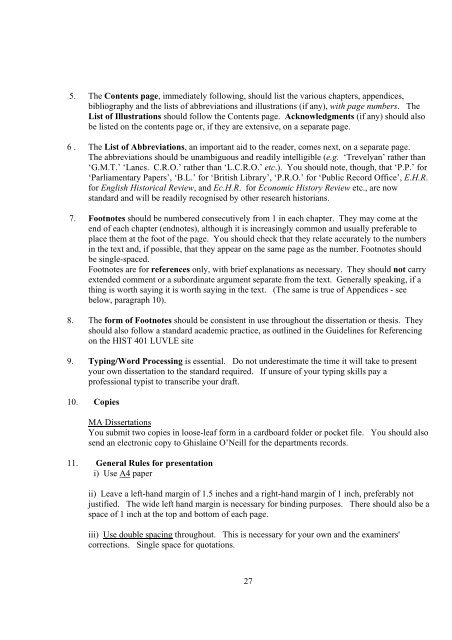M.A. in History Student Handbook 2011-2012
M.A. in History Student Handbook 2011-2012
M.A. in History Student Handbook 2011-2012
You also want an ePaper? Increase the reach of your titles
YUMPU automatically turns print PDFs into web optimized ePapers that Google loves.
5. The Contents page, immediately follow<strong>in</strong>g, should list the various chapters, appendices,<br />
bibliography and the lists of abbreviations and illustrations (if any), with page numbers. The<br />
List of Illustrations should follow the Contents page. Acknowledgments (if any) should also<br />
be listed on the contents page or, if they are extensive, on a separate page.<br />
6 . The List of Abbreviations, an important aid to the reader, comes next, on a separate page.<br />
The abbreviations should be unambiguous and readily <strong>in</strong>telligible (e.g. ‘Trevelyan’ rather than<br />
‘G.M.T.’ ‘Lancs. C.R.O.’ rather than ‘L.C.R.O.’ etc.). You should note, though, that ‘P.P.’ for<br />
‘Parliamentary Papers’, ‘B.L.’ for ‘British Library’, ‘P.R.O.’ for ‘Public Record Office’, E.H.R.<br />
for English Historical Review, and Ec.H.R. for Economic <strong>History</strong> Review etc., are now<br />
standard and will be readily recognised by other research historians.<br />
7. Footnotes should be numbered consecutively from 1 <strong>in</strong> each chapter. They may come at the<br />
end of each chapter (endnotes), although it is <strong>in</strong>creas<strong>in</strong>gly common and usually preferable to<br />
place them at the foot of the page. You should check that they relate accurately to the numbers<br />
<strong>in</strong> the text and, if possible, that they appear on the same page as the number. Footnotes should<br />
be s<strong>in</strong>gle-spaced.<br />
Footnotes are for references only, with brief explanations as necessary. They should not carry<br />
extended comment or a subord<strong>in</strong>ate argument separate from the text. Generally speak<strong>in</strong>g, if a<br />
th<strong>in</strong>g is worth say<strong>in</strong>g it is worth say<strong>in</strong>g <strong>in</strong> the text. (The same is true of Appendices - see<br />
below, paragraph 10).<br />
8. The form of Footnotes should be consistent <strong>in</strong> use throughout the dissertation or thesis. They<br />
should also follow a standard academic practice, as outl<strong>in</strong>ed <strong>in</strong> the Guidel<strong>in</strong>es for Referenc<strong>in</strong>g<br />
on the HIST 401 LUVLE site<br />
9. Typ<strong>in</strong>g/Word Process<strong>in</strong>g is essential. Do not underestimate the time it will take to present<br />
your own dissertation to the standard required. If unsure of your typ<strong>in</strong>g skills pay a<br />
professional typist to transcribe your draft.<br />
10. Copies<br />
MA Dissertations<br />
You submit two copies <strong>in</strong> loose-leaf form <strong>in</strong> a cardboard folder or pocket file. You should also<br />
send an electronic copy to Ghisla<strong>in</strong>e O’Neill for the departments records.<br />
11. General Rules for presentation<br />
i) Use A4 paper<br />
ii) Leave a left-hand marg<strong>in</strong> of 1.5 <strong>in</strong>ches and a right-hand marg<strong>in</strong> of 1 <strong>in</strong>ch, preferably not<br />
justified. The wide left hand marg<strong>in</strong> is necessary for b<strong>in</strong>d<strong>in</strong>g purposes. There should also be a<br />
space of 1 <strong>in</strong>ch at the top and bottom of each page.<br />
iii) Use double spac<strong>in</strong>g throughout. This is necessary for your own and the exam<strong>in</strong>ers'<br />
corrections. S<strong>in</strong>gle space for quotations.<br />
27
















